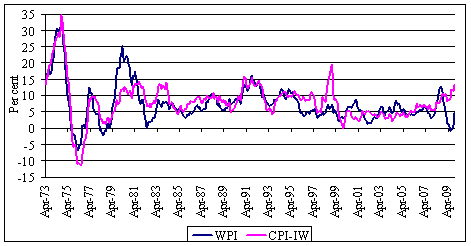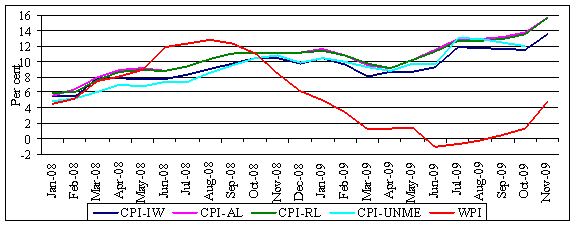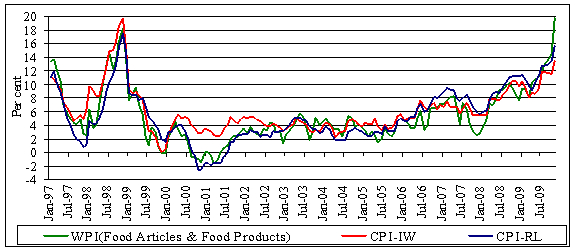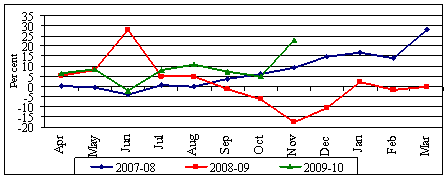 IST,
IST,


Measures of Inflation in India: Issues and Perspectives
Shri Deepak Mohanty, Executive Director, Reserve Bank of India
delivered-on ஜன. 14, 2010
I thank the Indian Association for Research in National Income and Wealth (IARNIW) for giving me this opportunity to speak on the important issue of inflation measurement in India which is a key theme of this year's Conference. The discussion is also timely as we would be moving into a new series of wholesale price index (WPI) with a more representative commodity basket and the proposal for broad-based consumer price indices (CPIs) in train. Moreover, there is now considerable discussion in India on inflation as consumer prices are in double digits and wholesale prices are rising. 2. In my talk today, I will briefly review the various primary measures of inflation with a particular reference to the divergence between WPI and CPI. I will also focus on different secondary (derived) measures of inflation, particularly core inflation, and end the discussion with some thoughts on the way forward. 3. What is Inflation? Why do we care so much about inflation? Inflation is a sustained increase in the overall level of prices. Since price stability is a key objective of monetary policy, central banks are obviously concerned with inflation. Prices of specific goods or services may go up or down relative to the prices of others reflecting changes in productivity or demand and supply conditions. But when the overall price level rises, it erodes the purchasing power of income, raises the cost of living and lowers the real value of savings. Savers, investors and financial intermediaries track closely the link between inflation and interest rate. The level of inflation is also critical in terms of maintaining competitiveness of domestic industry in a liberalised trading and market determined exchange rate regime. More importantly, it is the poor who are most vulnerable to inflation as they do not have any effective hedge against inflation. As Keynes said, "Inflation is the form of taxation which the public find hardest to evade." Thus, the issue of inflation and its measurement have always received lot of attention in India.I. Inflation Measures: Conceptual Issues 4. India has a rich tradition of collection and dissemination of price statistics dating back to 1861 when the Index of Indian Prices was released. Currently, there are five different primary measures of inflation - the Wholesale Price Index (WPI) and four measures of the Consumer Price Index (CPI). In addition, Gross Domestic Product (GDP) deflator and Private Final Consumption Expenditure (PFCE) deflator from the National Accounts Statistics (NAS) provide implicit economy-wide inflation estimate. The WPI is considered as the headline inflation measure because of its availability at high frequency1, until recently, national coverage and availability of disaggregated data which facilitate better analysis of inflation. 5. While the WPI does not cover prices of services, CPIs are meant to reflect the cost of living conditions for a homogeneous group of consumers based on retail prices. Among the four measures of CPI, the CPI for Industrial workers (IW) has a broader coverage than the others - the CPI for agricultural labourers (AL), rural labourers (RL) and urban non-manual employees (UNME). In the organised sector, CPI-IW is used as a cost of living index. 6. GDP Deflator, on the other hand, is a comprehensive measure of inflation, implicitly derived from national accounts data as a ratio of GDP at current prices to constant prices. While it encompasses the entire spectrum of economic activities including services, it is available on a quarterly basis with a lag of two months since 1996. Moreover, national income aggregates extensively use WPI for deflating nominal price estimates to derive real price estimates.7. Even as each of the measures has its strengths and weaknesses, the selected measure of inflation should broadly capture the interplay of effective demand and supply in the economy at frequent intervals. However, the trend in various measures of inflation during the recent years has raised several conceptual measurement issues of inflation. First, the divergence between WPI inflation and CPI inflation has widened. Second, the representativeness of WPI has reduced as it does not capture the price movement in the services sector which has a larger and increasing share of GDP - about 65 per cent in 2008-09. Third, old base periods - for WPI (1993-94), CPI-UNME (1984-85), CPI-RL (1986-87), CPI-AL (1986-87) and CPI-IW (2001) - fail to capture the rapid structural changes in the economy2. Divergence between WPI and CPI 8. Why do WPI and CPIs differ? They differ in terms of their weighting pattern. First, food has a larger weight in CPI ranging from 46 per cent in CPI-IW to 69 per cent in CPI-AL whereas it has a weight of only 27 per cent3 in WPI. The CPIs are, therefore, more sensitive to changes in prices of food items. Second, the fuel group has a much higher weight in the WPI (14.2 per cent) than the CPIs (5.5 to 8.4 per cent). As a result, movement in international crude prices has a greater bearing on WPI than on the CPIs. Third, services are not covered under WPI while they are, to different degrees, covered under CPIs. Consequently, service price inflation has a greater influence on CPIs. 9. As the retail market receives commodities from wholesale market, it is expected that the change in the prices of commodities in wholesale market would normally transmit to the retail market. Granger causality test in a vector auto-regression (VAR) framework using monthly WPI and CPIs indicates that at the trend level CPIs lag behind WPI by a month. There is also a long run cointegrating relationship between WPI and CPI.Therefore, WPI and CPIs in India may not move away from each other in the long-run if this observed relationship continues to hold (Chart 1). Chart 1: Long-run relationship between WPI and CPI Inflation
10. In addition, annual inflation based on WPI, CPI-IW, GDP deflator, and PFCE deflator, over longer time spans, followed a similar path (Table 1). Table 1: Decadal Average Inflation
11. Notwithstanding the long-run lead-lag relationship, the divergence between WPI and CPI has accentuated since early 2008 (Chart 2). Chart 2: Divergence between WPI and CPI Inflation
12. This could be attributed to the following factors. First, the price of minerals and metals went up sharply during May-June 2008 and then fell precipitously reflecting global trends. Since metals and alloys do not form a part of the CPI group, this accentuated the divergence between CPI and WPI. Second, there was a similar trend as metals in crude prices which had a larger influence on WPI than CPI. Third, price of services - such as, medical care, education, recreation and amusement, transport and communication and personal care and effects - in CPI-IW showed a significant inflation of over 8 per cent. It may, however, be indicated that CPIs recorded very similar trends as the food component of WPI despite the divergence of the overall indices during the recent period (Chart 3). Chart 3: Co-movement of Inflation Rates based on WPI (Food) and CPIs
New WPI Series 13. Following the recommendation of the Working Group for Revision of Wholesale Price Index (Chairman: Prof. Abhijit Sen), the base year is being updated to 2004-05. The proposed basket of manufactured products in the new series would cover significantly a higher number of commodities and would integrate items from both organised and un-organised manufacturing sectors. While this would improve coverage, the challenge is to ensure collection of price data on a regular basis so that the quality could be maintained. The revised WPI basket, however, would not include services prices. An Expert Group (Chairman: Prof. C. P. Chandrasekhar) is looking into process of developing a service price index. In order to enhance the representativeness of WPI index, it is important to expand the coverage to include services. Producer Price Index 14. Even when we have a revised WPI, we would still not have a Producer Price Index (PPI). The PPI covers price changes faced by the producers on primary, intermediate and finished goods and services ready for the market. The primary difference between the WPI and the PPI is, in addition to the coverage, that the WPI reflects changes in the average cost of production including mark-ups and taxes, while the PPI measures price changes of transacted goods at the gate excluding taxes. The purpose of the PPI is to provide a measure of prices received by producers of commodities. The PPI usually covers the industrial (manufacturing) sector as well as public utilities (electricity, gas and communications). Some countries also include agriculture, mining, transportation, and business services. Most of the countries replaced WPIs with PPIs in the 1970s and 1980s. For analytical purposes, it would be desirable to initiate the process of compilation of PPI for India. New Consumer Price Indices 15. At the retail level, CPI is meant to reflect the cost of living conditions and is computed on the basis of the changes in the level of retail prices of selected goods and services on which consumers spend the major part of their income. Therefore, a broad based CPI for the country as a whole, including both services and manufacturing products, has greater relevance for monetary policy formulation. 16. In India, however, data on CPI relates to different segments of the population rather than the entire population. With a view to addressing this issue, the Reserve Bank had taken the initiative and prepared an approach paper on CPI (Urban) and CPI (Rural). Subsequently, the Central Statistical Organisation (CSO) has taken up the work for generating data on CPI (Urban) and CPI (Rural). The new CPIs once complied will go a long way in filling a major data gap in price statistics. II. Secondary (Derived) Measures of inflation 17. A representative measure of inflation for the country as a whole and availability of information on inflation at high frequency with limited time lag are important for the conduct of monetary policy. A number of empirical works based on the long-run equilibrium analysis have found that money supply (M3) and WPI series are cointegrated to a fair extent, thus providing evidence on the WPI being more amenable to monetary policy changes (Reddy, 1999). The Report of the Working Group on Money Supply (1998) also used WPI as inflation measure and found that the nominal money demand equation showed long-run price elasticity close to unity. Even though conventionally WPI inflation has been used as the headline inflation, several limitations have emerged in the recent past that complicate a realistic assessment of inflation based essentially on WPI. This underscores the need for a representative measure of inflation for better articulation of monetary policy with the objective to anchor inflationary expectations. Since inflation objective has to be pursued by the Reserve Bank, to avoid any conflict of interest, the primary statistics on inflation should be generated by another statistical agency.Deseasonalised Trend Inflation 18. Apart from the headline inflation, for policy purposes, central banks look at various secondary (derived) measures of inflation to gauge the underlying inflationary pressures. One such indicator of inflationary momentum is annualized month-over-month seasonally adjusted inflation. However, the use of such indicator for emerging market economies like India has its limitations because it could be quite volatile (Chart 4). Chart: 4 Annualised M-o-M WPI (seasonally adjusted) Inflation
Core Inflation 19. Another way to analyse inflation data is by looking at “core inflation,” which is generally a chosen measure of inflation that excludes the more volatile categories like food and energy prices. The main argument here is that the central bank should effectively be responding to the movements in permanent component of the price level rather than temporary deviations. Table 2: Various WPI-based Core Inflation Measures4
20. There are many variants of core inflation which try to remove the volatility of price changes by statistical means. These include truncation of commodities based on standard deviation of price changes, trimmed mean, median and other filter based smoothing techniques. Various measures of WPI-based core inflation for the years 2008-09 and 2009-10 are presented in Table 2. It can be seen that the core measures show significant month to month variations, though the volatility has been lower compared to the headline measure. Since core inflation is derived from the headline, it reflects the weaknesses in the primary measure of inflation. A prerequisite of a good inflation measure is that it is broader in coverage and the base period is updated frequently reflecting structural changes in the economy. 21. In Indian context, the derivation of core inflation by exclusion of food and energy from CPI/WPI discards a substantial portion of the commodity basket. So the price movement of the remaining commodities may not be representative of the underlying inflationary trend. Although these prices have substantial effects on the overall index, they often are quickly reversed. But the reversal of volatile prices sometimes is not short-lived. Therefore, determining when to use a core inflation measure versus an overall inflation measure remains a complex issue. III. Way Forward 22. The divergence between alternative inflation measures complicates the conduct of monetary policy in India. Accordingly, the Reserve Bank looks at all the measures of inflation, both overall and disaggregated components, in conjunction with other economic and financial indicators, to assess the underlying inflationary conditions. As indicated by Governor Dr. Subbarao, “the Reserve Bank has been constantly engaged in the refinements of the various price indices and would continue to provide the necessary support to the Government to bring about further improvements in the measurement of inflationary conditions”. 23. In the context of monetary policy formulation, it is important to have a robust primary measure of inflation at the national level. In this direction, the compilation of CPI (Urban) and CPI (Rural) could pave the way for a representative CPI for the country. There is also a need to augment the new series of WPI with a service price index to improve its overall coverage. In addition, it would be desirable to initiate steps to develop a producer price index (PPI) for the country. Moreover, the representativeness of the various price indices could be enhanced by frequent updation of the base year so that it reflects the structural change in the economy. Thank you. References Barman, R. B. and A.K. Nag (2002): “Inflation in India: A multidimensional view through various price indices” in National Income Accounts and Data Systems, ed., B. S. Minhas, Oxford University Press. Central Statistical Organisation (2007): National Accounts Statistics - Sources and Methods. D. Subbarao (2009): "Inaugural Address: Third Annual Statistics Day Conference" Reserve Bank of India Bulletin, August. Das A., J. John and S. Singh (2009): “Core Inflation: Issues and Measurement”, Indian Economic Review (forthcoming). Mohanty D, D P Rath and M Ramaiah (2000): “Measures of Core Inflation for India”, Economic and Political Weekly, 35(5). Reddy, Y. V. (1999): Inflation in India: Status and Issues, speech delivered at Centre for Economic and Social Studies, Hyderabad. Reserve Bank of India (1998): Report of Working Group on Money Supply: Analytics and Methodology of Compilation (Chairman: Dr. Y V Reddy). Samanta, G.P. (1999): “Core Inflation in India: Measurement and Policy Perspectives”, Reserve Bank of India Occasional Papers, 20(1). Srinivasan, T.N. (2008): “Price Indices and Inflation Rates”, Economic and Political Weekly, 43(26). * Speech by Deepak Mohanty, Executive Director, Reserve Bank of India, at the Conference of Indian Association for Research in National Income and Wealth (IARNIW) at the Centre for Development Studies (CDS), Thiruvananthapuram, January 9, 2010. The assistance of Dr. Abhiman Das is acknowledged. 1 WPI was available on a weekly basis with a lag of two weeks till October 24, 2009. Now the prices for two sub-groups – primary article (weight in WPI: 22.03 per cent) and fuel and power, light and lubricants (weight in WPI: 14.23 per cent) are available on a weekly basis with a lag of a fortnight. The overall WPI index is available on a monthly basis with a lag of a fortnight. 2 It may be mentioned that the System of National Accounts (SNA) 1993 has been impressing the national statistical agencies for regular updation of the base. In general, revision of base in every 5 years is an accepted principle in major developed and emerging countries. 4 1.5 SD method: This method excludes all those commodities in which percentage price change is more than mean plus/minus 1.5 standard deviation over mean price change. Median: This procedure computes price change for all the commodities, arrange them in ascending order, calculate cumulative weight of the new series and take the inflation of the first commodity for which cumulative weight is greater than or equal to 50 per cent. Reweighting: In this method, we compute price change, calculate standard deviation of price change for WPI-All Commodities as well as each commodities over a period of time, calculate historical standard deviation for each commodity as the difference between WPI-All Commodities standard deviation and standard deviation of that commodity. Then, we calculate final weight as the reciprocal of historical standard deviation, multiplied by initial weight. 5 * and ** indicate that the core inflation standard deviation is lower and significantly different from the standard deviation of headline inflation at 1% and 5% level of significance, respectively. |
கடைசியாக புதுப்பிக்கப்பட்ட பக்கம்:





















